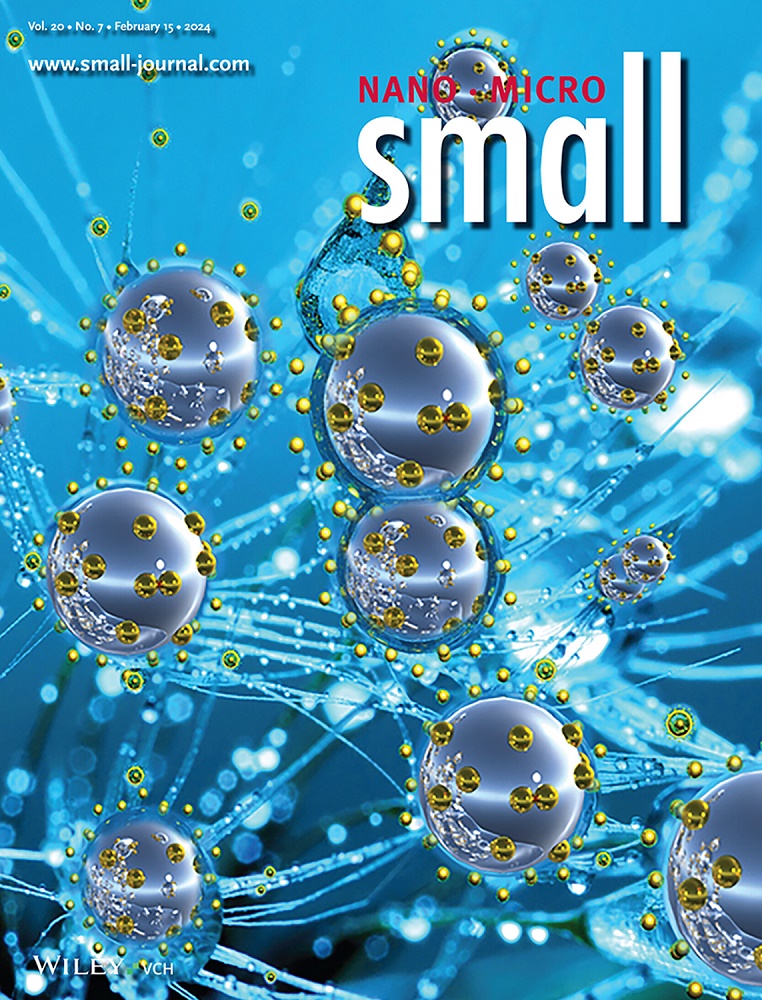Micro Bubble Blanket Coated Nano-Ridge Surfaces for Robust and Efficient Thermal Management.
IF 12.1
2区 材料科学
Q1 CHEMISTRY, MULTIDISCIPLINARY
引用次数: 0
Abstract
To achieve robust and high-efficient thermal management at micro scale, this study focuses on interplay of a micro bubble blanket and lifting large bubbles on locally heated surfaces with nano-ridge structures. The micro bubble blanket covers the surface dynamically after heat fluxes exceed a criterion where heat transfer coefficients exhibit constant values, highlighting the robust and predictable two-phase heat transfer. By quantitative investigations of diameters as well as lifting speed of large bubbles, it ensures that convective boiling heat transfer mechanism dominates without forced convection, accounting for constant heat transfer coefficient at high-heat-flux regions. Force analyses are adopted to investigate the individual micro bubbles that form the bubble blanket, which is pinned downside to nano-ridge surfaces by free energy while pulled upside by merging effect of buoyancy-driven large bubbles. The presence of the bubble blanket facilitates the removal of large bubbles by modifying the surface tension distribution, sustaining safe boiling heat transfer across a broad range of heat fluxes. This approach achieves a convective boiling mechanism without the need for power equipment, opening a new paradigm in microscale heat removal that is both robust and energy-efficient.微气泡毯涂层纳米脊表面稳健和有效的热管理。
为了在微观尺度上实现强大而高效的热管理,本研究重点研究了微气泡毯与纳米脊结构在局部加热表面上提升大气泡的相互作用。当热通量超过传热系数呈现恒定值时,微气泡毯动态覆盖表面,突出了两相传热的鲁棒性和可预测性。通过对大气泡直径和升速的定量研究,保证了对流沸腾换热机制占主导地位,没有强制对流,在高热流密度区域换热系数恒定。采用力分析的方法研究了形成气泡毯的单个微气泡,气泡毯在自由能的作用下向下固定在纳米脊表面,在浮力驱动的大气泡的合并作用下向上拉。气泡毯的存在通过改变表面张力分布,促进了大气泡的去除,在广泛的热流密度范围内维持安全的沸腾传热。这种方法在不需要动力设备的情况下实现了对流沸腾机制,开辟了一个既坚固又节能的微尺度除热的新范例。
本文章由计算机程序翻译,如有差异,请以英文原文为准。
求助全文
约1分钟内获得全文
求助全文
来源期刊

Small
工程技术-材料科学:综合
CiteScore
17.70
自引率
3.80%
发文量
1830
审稿时长
2.1 months
期刊介绍:
Small serves as an exceptional platform for both experimental and theoretical studies in fundamental and applied interdisciplinary research at the nano- and microscale. The journal offers a compelling mix of peer-reviewed Research Articles, Reviews, Perspectives, and Comments.
With a remarkable 2022 Journal Impact Factor of 13.3 (Journal Citation Reports from Clarivate Analytics, 2023), Small remains among the top multidisciplinary journals, covering a wide range of topics at the interface of materials science, chemistry, physics, engineering, medicine, and biology.
Small's readership includes biochemists, biologists, biomedical scientists, chemists, engineers, information technologists, materials scientists, physicists, and theoreticians alike.
 求助内容:
求助内容: 应助结果提醒方式:
应助结果提醒方式:


